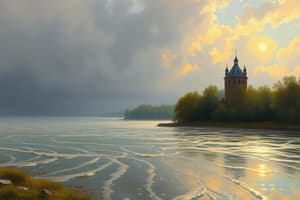Podcast
Questions and Answers
What was one of the key factors limiting agriculture in Europe from the fifth to the tenth centuries?
What was one of the key factors limiting agriculture in Europe from the fifth to the tenth centuries?
- Sudden increase in average temperatures
- Intensely cold climatic spell
- Shortened growing season due to prolonged winters
- Vast forests covering most of Europe (correct)
Why did peasants have the option to flee from oppression and seek refuge in the forest during the fifth to tenth centuries?
Why did peasants have the option to flee from oppression and seek refuge in the forest during the fifth to tenth centuries?
- Vast expansion of agricultural lands
- Reduced yields from agriculture
- Severe and prolonged winters
- Warm climatic phase in Europe (correct)
What was a significant environmental impact of Europe entering a warm phase from the eleventh century onwards?
What was a significant environmental impact of Europe entering a warm phase from the eleventh century onwards?
- Increased forest cover
- Shortened growing season for crops
- Receding of the forest line in many parts of Europe (correct)
- Higher chances of frost affecting the soil
How did the longer growing season in Europe from the eleventh century onwards impact agriculture?
How did the longer growing season in Europe from the eleventh century onwards impact agriculture?
What allowed for the expansion of the area under cultivation in Europe after the eleventh century?
What allowed for the expansion of the area under cultivation in Europe after the eleventh century?
What was the major environmental challenge faced by Europe in the fifth to tenth centuries?
What was the major environmental challenge faced by Europe in the fifth to tenth centuries?
How did the warm phase in Europe from the eleventh century impact agriculture?
How did the warm phase in Europe from the eleventh century impact agriculture?
What enabled the expansion of the area under cultivation in Europe after the eleventh century?
What enabled the expansion of the area under cultivation in Europe after the eleventh century?
What limited the land available for agriculture in Europe from the fifth to tenth centuries?
What limited the land available for agriculture in Europe from the fifth to tenth centuries?
Why were peasants able to flee from oppression and seek refuge in the forest during the fifth to tenth centuries?
Why were peasants able to flee from oppression and seek refuge in the forest during the fifth to tenth centuries?
Flashcards are hidden until you start studying
Study Notes
Key Factors Limiting Agriculture (5th to 10th centuries)
- Frequent invasions and instability disrupted agricultural practices, leading to a reliance on subsistence farming.
- Poor soil fertility and limited agricultural techniques resulted in low crop yields.
Peasants and Escape to Forests
- Peasants fled oppression due to the lack of political rights and heavy taxation imposed by feudal lords.
- Forests provided natural refuge and resources, allowing peasants to survive independently.
Environmental Impact of Warm Phase (11th century onwards)
- The warming period led to expanded agricultural opportunities, as milder temperatures increased productivity.
- Increased rainfall during this period benefited crop growth and soil moisture levels.
Impact of Longer Growing Season (11th century onwards)
- The extended growing season allowed for multiple crop cycles per year, enhancing food security.
- Improved conditions led to the cultivation of new crops beyond traditional staples.
Expansion of Cultivated Area (After 11th century)
- Technological advancements, such as the heavy plow and crop rotation, enabled more effective farming practices.
- Increased demand for food due to population growth motivated land reclamation and forest clearing for agriculture.
Major Environmental Challenge (5th to 10th centuries)
- Deforestation and soil degradation limited agricultural productivity and contributed to food scarcity.
- Harsh climatic conditions, including colder temperatures, further hindered farming efforts.
Agricultural Improvement Due to Warm Phase (11th century)
- The warm phase fostered greater agricultural diversity and higher yields.
- Advances in farming techniques and a shift in climate patterns supported sustained crop production.
Factors Enabling Agricultural Expansion (After 11th century)
- Innovations like the windmill and watermill facilitated increased efficiency in farming operations.
- The emergence of trade networks expanded markets for surplus produce, incentivizing cultivation growth.
Studying That Suits You
Use AI to generate personalized quizzes and flashcards to suit your learning preferences.




